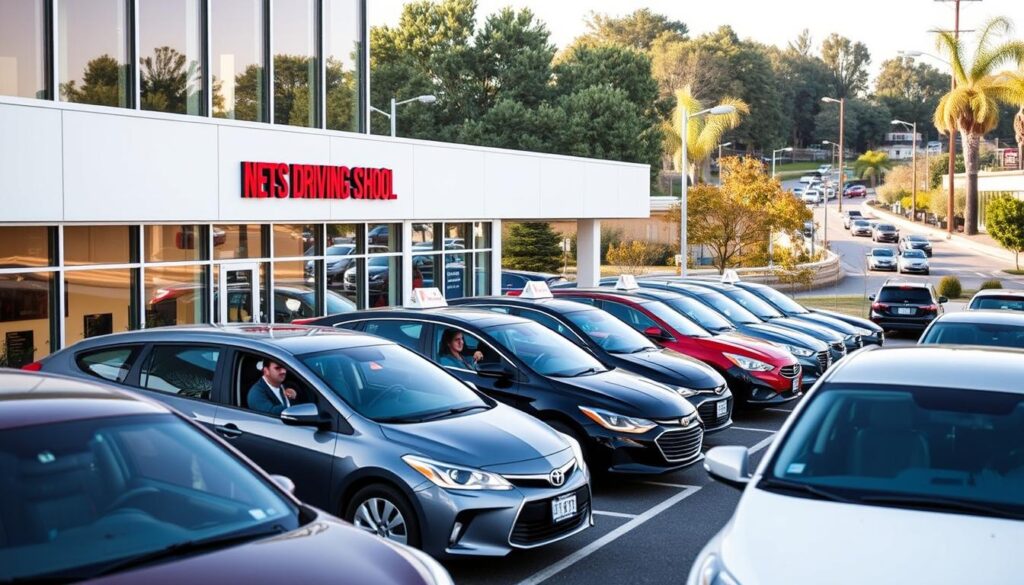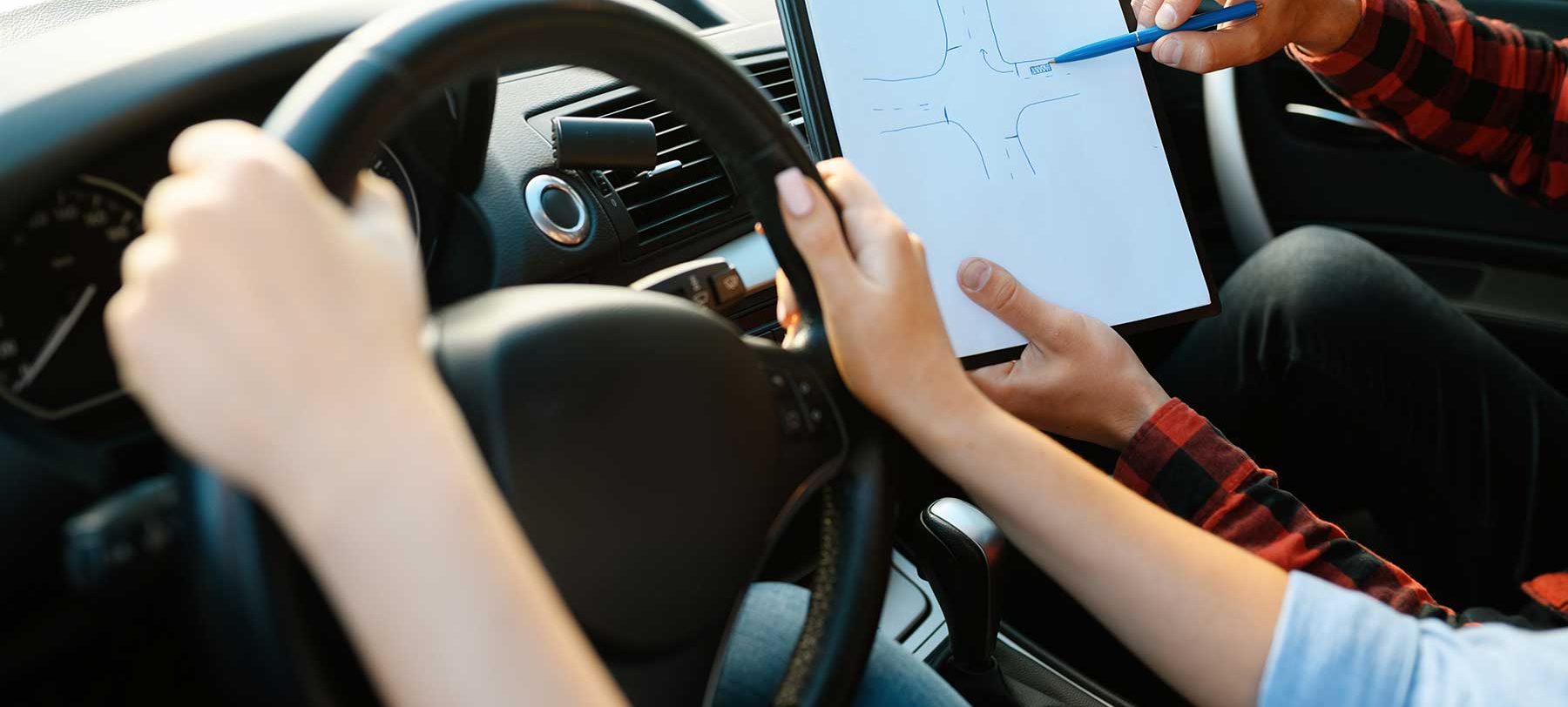Winter weather can create treacherous road conditions, posing serious risks to drivers. It’s crucial to take precautions and prepare yourself and your vehicle for the challenges of winter driving. Follow these essential winter driving tips to ensure your safety on icy roads.
Key Takeaways:
- Slow down and increase your following distance to allow for safe braking in slippery conditions.
- Be prepared in case of an emergency by staying with your vehicle and making it visible to other drivers.
- Regularly check your tire pressure, tread depth, and consider using snow tires for better traction.
- Ensure car seat safety by using thin, warm layers instead of bulky coats and properly securing the harness.
- Check your battery and familiarize yourself with your vehicle’s safety technologies for better control in wintry conditions.
Slow Down and Increase Following Distance
When driving in snow or icy conditions, it’s essential to adjust your driving habits to ensure your safety on the road. One of the most crucial winter driving tips is to slow down and increase your following distance. The slippery surface makes it harder to control and stop your vehicle, so reducing your speed will give you more control and allow for better reaction time.
By maintaining a safe following distance, you create a buffer zone between your vehicle and the one in front of you, reducing the risk of rear-end collisions. The general rule of thumb is to leave at least three times the normal following distance in snowy or icy conditions. This gives you enough time to stop or maneuver if the vehicle ahead suddenly slows down or encounters an obstacle.
Apart from the increased likelihood of accidents, speeding and tailgating can have serious consequences. In wintry conditions, there were an estimated 119,000 police-reported crashes in 2020. Don’t let yourself become part of that statistic. Slow down, be patient, and keep a safe distance to ensure a smooth and accident-free journey.
Driving in Snow and Icy Conditions: Important Safety Tips
- Reduce your speed to maintain control of your vehicle.
- Increase your following distance to have enough time to stop.
- Avoid tailgating and aggressive driving.
- Use extra caution on bridges, overpasses, and shaded areas, as they tend to freeze first.
- Accelerate and decelerate slowly to maintain traction.
- Don’t use cruise control in slippery conditions.
- Brake gently and early to avoid skidding.
- Steer smoothly and avoid abrupt turns or lane changes.
- Keep your headlights on for better visibility.
- If you get stuck, turn your wheels from side to side to clear the snow around them and try to rock the vehicle gently out of the rut.
Remember, driving in snow or icy conditions requires extra caution and patience. By slowing down, increasing your following distance, and practicing safe driving habits, you can minimize the risks and safely navigate through winter’s challenging road conditions.
Be Prepared in an Emergency
When driving in winter weather, it’s essential to be prepared for the possibility of an emergency situation. Whether you find yourself stopped or stalled on icy roads, being aware of what to do can make all the difference. Here are some important winter driving advice and tips to help you stay safe in an emergency:
Stay Focused and Stay with Your Car
If you find yourself in a situation where you are stopped or stalled in wintry weather, the first and most crucial step is to stay focused and remain with your vehicle. This will ensure that you are visible to other drivers and emergency responders. Avoid overexerting yourself and remember that it’s safer to wait for help to arrive.
Make Your Vehicle Visible
Visibility is key when it comes to being prepared in an emergency. Use bright markers or reflective tape to make your vehicle more visible to other drivers. Additionally, keep your interior dome light on to make it easier for rescuers to locate you. These simple steps can greatly increase your chances of being noticed and receiving assistance.
Prevent Carbon Monoxide Poisoning
One of the hidden dangers during an emergency situation is carbon monoxide poisoning. If you need to run your vehicle for warmth, ensure that your exhaust pipe is clear of snow and debris, and keep a window slightly cracked to allow fresh air in. Carbon monoxide can be deadly, so it’s important to take precautions to prevent its buildup in your vehicle.
By following these winter driving tips and being prepared in an emergency, you can increase your safety and the safety of those around you. Remember to stay focused, make your vehicle visible, and be mindful of carbon monoxide poisoning. Stay safe on the icy roads this winter!
Check Your Tires
When it comes to winter driving, proper tire maintenance is crucial for your safety on icy roads. As the temperature drops, tire inflation pressure decreases, compromising traction and control. To ensure your tires are ready for winter weather, follow these essential tips.
- Check Tire Inflation: Regularly inspect each tire and make sure it is filled to the recommended inflation pressure as listed in your owner’s manual. Maintaining proper tire pressure increases grip and stability on slippery surfaces.
- Inspect for Damage: Examine your tires for any signs of wear, bulges, or punctures. Damaged tires can be more susceptible to loss of traction and blowouts, so it’s important to replace them if necessary.
- Check Tread Depth: The tread depth of your tires is crucial for grip on icy roads. To ensure adequate traction, use a tread depth gauge or perform the “penny test” by inserting a penny into the tread groove. If you can see the top of Lincoln’s head, it’s time to replace your tires.
- Consider Snow Tires: If you live in an area with heavy snowfall or frequent icy conditions, investing in snow tires can greatly enhance your winter driving safety. Snow tires have deeper treads and special rubber compounds designed to provide superior traction on snowy and icy surfaces.
By following these tire maintenance tips, you can improve your vehicle’s performance and reduce the risk of accidents on winter roads. Remember, your tires are the only point of contact between your vehicle and the road, so it’s essential to keep them in optimal condition.
| Tire Maintenance Tips | Benefits |
|---|---|
| Regularly check tire inflation pressure | Improved grip and stability |
| Inspect tires for damage | Reduced risk of blowouts |
| Check tread depth | Enhanced traction on icy roads |
| Consider snow tires | Superior performance in heavy snow and ice |
Don’t overlook the importance of tire maintenance in your winter driving preparations. Take the time to check your tires before the cold weather sets in, and ensure they are in optimal condition to navigate the challenges of winter roads.
Ensure Car Seat Safety
When it comes to winter driving precautions, keeping your child safe in the car is of utmost importance. Cold weather can present unique challenges for car seat safety, but with the right knowledge and precautions, you can ensure your child stays secure on the road.
In colder temperatures, it’s essential to consider the proper fit of your child’s car seat harness. Thick, heavy coats can interfere with the harness’s ability to properly secure your child in the event of a crash. Instead of bulky winter coats, opt for thin, warm layers that allow the harness to fit snugly against your child’s body. After securing the harness, you can use blankets or coat them for extra warmth.
Correct installation of car seats and booster seats is also crucial for ensuring your child’s safety. Make sure you follow the manufacturer’s instructions and guidelines for installing the seat correctly. Additionally, choose a car seat or booster seat that is appropriate for your child’s age and size. The National Highway Traffic Safety Administration (NHTSA) provides a Child Car Seat Inspection Station Locator that can assist you in ensuring your car seat is properly installed.
Key Points:
- Choose thin, warm layers instead of bulky coats to ensure the proper fit of your child’s car seat harness.
- Secure the harness snugly against your child’s body and use blankets or coats for extra warmth.
- Follow the manufacturer’s instructions and guidelines for correct installation of car seats and booster seats.
- Select a car seat or booster seat that is appropriate for your child’s age and size.
- Use the NHTSA’s Child Car Seat Inspection Station Locator to verify proper installation.

| Winter Car Seat Safety Tips | |
|---|---|
| 1 | Choose thin, warm layers instead of bulky coats to ensure proper harness fit. |
| 2 | Secure the car seat harness snugly against your child’s body. |
| 3 | Use blankets or coats for extra warmth after securing the harness. |
| 4 | Follow manufacturer’s instructions for correct car seat installation. |
| 5 | Choose a car seat or booster seat appropriate for your child’s age and size. |
| 6 | Use the NHTSA’s Child Car Seat Inspection Station Locator to ensure proper installation. |
Check Battery and Safety Technologies
As the winter season approaches, it is essential to ensure that your vehicle is equipped with a reliable battery and advanced safety technologies to navigate the challenging road conditions. Cold weather can significantly impact battery performance, leading to difficulties in starting your vehicle. To avoid any inconveniences, I recommend having your battery and charging system checked by a mechanic before the onset of winter. This will help identify any issues and ensure that your battery is in optimal condition to handle the demands of the season.
In addition to checking your battery, familiarizing yourself with the safety technologies in your vehicle is crucial for safe winter driving. Features such as antilock brakes, traction control, and stability control can greatly enhance your ability to maintain control in wintry conditions. Take the time to read your vehicle’s manual and understand how these systems work. Knowing how to properly utilize these safety technologies will not only keep you and your passengers safe but also give you the confidence to navigate icy roads with ease.
Remember, prevention is key when it comes to winter driving. By proactively checking your battery and becoming familiar with your vehicle’s safety technologies, you are taking important steps to ensure a safe and stress-free winter driving experience. Don’t let the cold weather catch you off guard – make sure your battery is in good shape, and you are well prepared to handle any challenging road conditions that winter may bring.

Winter Driving Precautions
- Have your battery and charging system checked by a mechanic before winter.
- Familiarize yourself with the safety technologies in your vehicle and understand how to use them properly.
- Be proactive in your approach to winter driving by taking steps to ensure your vehicle is prepared for the challenges of icy roads.
“Safe winter driving starts with being prepared and having the right equipment. A reliable battery and understanding your vehicle’s safety technologies are essential for a smooth and safe journey.” – John Smith, Winter Driving Expert
| Winter Driving Tips | Benefits |
|---|---|
| Check your battery and charging system | Ensures reliable vehicle starting and operation |
| Familiarize yourself with safety technologies | Improves control and stability on icy roads |
| Be proactive in winter preparation | Reduces the risk of breakdowns and accidents |
Conclusion
Safe winter driving is essential for navigating icy roads and minimizing the risk of accidents. By following these winter driving tips, you can ensure your safety and the safety of others on the road.
Remember to always slow down and increase your following distance when driving in snow or icy conditions. This will give you enough time to react to any potential hazards and avoid collisions.
Being prepared for emergencies is vital during winter weather. Stay with your car if you’re stopped or stalled, and make sure it’s visible to other drivers. Check your tires regularly for proper inflation and tread depth, and consider using snow tires for better traction.
Lastly, make sure your car seat is safely installed and appropriate for your child’s age and size. Layer clothing instead of using heavy coats that can interfere with the proper fit of the car seat harness.
With these winter driving tips in mind, you can confidently navigate through any winter storm and arrive at your destination safely. Stay safe and enjoy the beauty of the winter season!
FAQ
Why is it important to slow down and increase following distance when driving in winter weather?
Winter weather can create slick and snow-covered surfaces, making it harder to control or stop your vehicle. Slowing down and increasing your following distance gives you more time to react and stop safely, reducing the risk of accidents.
What should I do if I am stopped or stalled in wintry weather?
If you find yourself stopped or stalled in wintry weather, it is crucial to stay focused on yourself, your car, and your surroundings. Stay with your car, avoid overexerting yourself, and make your car visible by using bright markers and keeping the interior dome light on. Be mindful of carbon monoxide poisoning by ensuring your exhaust pipe is clear and running your car only sporadically.
Why should I check my tire pressure and tread depth in winter?
As the outside temperature drops, tire inflation pressure also decreases. It is important to check that each tire is filled to the recommended inflation pressure to maintain proper traction. Additionally, inspect your tires regularly for any damage and check the tread depth to ensure it meets the minimum requirement of 2/32 of an inch. Consider installing snow tires for even better traction in winter conditions.
What precautions should I take when securing a child’s car seat in cold weather?
In colder weather, heavy coats can interfere with the proper fit of a child’s car seat harness. Instead of bulky coats, choose thin, warm layers for your child and use blankets or coats for extra warmth after securing the harness properly. Make sure car seats and booster seats are correctly installed and appropriate for the child’s age and size.
Why should I have my battery and charging system checked in winter?
Battery power decreases in cold weather, which can affect the starting ability of your vehicle. It is important to have your battery and charging system checked by a mechanic to ensure they are in good working condition. Additionally, familiarize yourself with the safety technologies in your vehicle, such as antilock brakes, and know how to use them properly to maintain visibility and control in wintry conditions.
What are some essential winter driving tips for staying safe on icy roads?
Safe winter driving requires preparation, cautious driving, and awareness of potential hazards. By following essential winter driving tips such as slowing down, increasing following distance, checking tires, securing car seats properly, and checking battery and safety technologies, you can navigate icy roads with confidence and reduce the risk of accidents.







